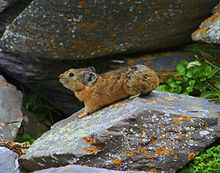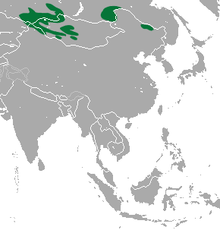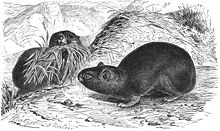Alpine pika
| Alpine pika | |
|---|---|

| |
| In the Saylyugem Mountains in Mongolia | |
| Scientific classification | |
| Domain: | Eukaryota |
| Kingdom: | Animalia |
| Phylum: | Chordata |
| Class: | Mammalia |
| Order: | Lagomorpha |
| Family: | Ochotonidae |
| Genus: | Ochotona |
| Species: | O. alpina
|
| Binomial name | |
| Ochotona alpina (Pallas, 1773)
| |
| Subspecies[2] | |
| |

| |
| Alpine pika range | |
| Synonyms[2] | |
| |
The alpine pika (Ochotona alpina) is a species of small
Taxonomy
German
The
Description
The alpine pika measures 152 to 235 mm (6.0 to 9.3 in) in length, has long rounded ears ranging from 17 to 26 mm (0.67 to 1.02 in) in length, and weighs 226 to 360 g (8.0 to 12.7 oz).
The summer pelage of different subspecies varies drastically but is generally dark or cinnamon brown. The back is dull, yellowish, ochre-grey in colour, with dark brown to black tips of the hairs. The
Despite geographic and seasonal variation, in sympatric zones, the adult alpine pika is larger than the adult northern pika by body measurements, and is usually more dull coloured.[5]
Distribution and habitat
The alpine pika inhabits mountainous areas in western Mongolia bordering the
The animal tends to be found in rocky habitats.
The alpine pika's habitat is separated from that of the northern pika by altitude or by microhabitat in their zone of sympatry, and it lives at both higher and lower altitudes than the northern pika. It is found at heights of 400 to 2,500 m (1,300 to 8,200 ft) above sea level in the Altai Mountains, and above 2,000 metres (6,600 ft) in China.[1][5]
In the early 1970s, an unexplained decline in the alpine pika population occurred throughout the western Sayan Mountains. Although in 1977 Khlebnikov suggested it was due to an epidemic, it was difficult to ascertain if such a large territory had been affected all at once. By 1986 or 1987, a few localities that had high alpine pika population densities 16 to 17 years earlier became devoid of the species, due to its low reproductive rate and the insular nature of its habitat.[5]
Behaviour and ecology

The alpine pika is a generalist herbivore, mainly foraging for mosses, trees branches, pine nuts, and plant stems, which it gathers during the summer to create haypiles for use in winter.
The species lives in families, with population densities of 10 to 12 individuals per hectare.[9] Family feeding territories do not overlap with each other, and mostly remain the same each year; however, the home territories of different family groups are larger and do overlap with each other. Both males and females have been observed to mark corners of stones mostly located near the center of their home territory, from April to December, by rubbing their neck glands against them.
The female's fecundity is low, as with other pikas inhabiting talus piles, and the size of litters decreases as the elevation increases. A.F. Potapkina observed a seasonal increase in the number of offspring per litter. On average, the female of the western Altai Mountains produces two litters, while in the northwestern Altai and the western Sayan Mountains she produces 2.7 litters—with 10% producing up to three litters in the latter case. In 1984, G.I. Makushin and G.I. Orlov determined the average annual mortality rate of the alpine pika to be 53% for populations living in forests and 41% for those living in the alpine zones—most of them aged between one and three years. The annual population density fluctuations of most populations were insignificant.[5]
Vocalizations
The alpine pika can emit three different vocalizations. The long call is heard during the mating season from only the subspecies O. a. alpina, O. a. changaica, and O. a. nitida. The short call is a harsh, sharp whistle that is easily distinguishable from the short high-pitched whistle of the northern pika. The alarm call is given out immediately any danger from predators or humans is perceived, and can travel greater distances than the calls of most other pika species.[5][9]
Parasites
Internal parasites of the alpine pika include many
Status and conservation
Since 1996, the alpine pika has been rated a species of
References
Notes
- ^ . Retrieved 17 November 2021.
- ^ OCLC 62265494.
- ^ Pallas 1773.
- ^ Armstrong, Fitzgerald & Meaney 2010, p. 260.
- ^ a b c d e f g h i j k l m Chapman & Flux 1990, p. 21.
- ISSN 0008-7114.
- S2CID 21980827.
- ^ Wilson & Reeder 2005, p. 189.
- ^ ISBN 978-1400834112.
- ^ Alves, Ferrand & Hacklände 2008, p. 91.
- ^ Spasski, A. A.; Rizhikov, K. M. (1951). "Helminths of Ochotona alpina Pall, in the Baikal region". Trudy Gel'mintologicheskoi Laboratorii. Akademiya Nauk SSSR. 5: 34–41.
- ^ a b Gvozdev, E. V. (1967). "New nematodes from Ochotona alpina Pall". Helminthologia. 7: 273–278.
- ^ Gvozdev, E. V. (1951). "A new species of tapeworm belonging to the family Anoplocephalidae from Ochotona alpina". Trudy Gel'mintologicheskoi Laboratorii Akademiya Nauk SSSR. 5: 143–145.
Bibliography
- Alves, Paulo C.; Ferrand, Nuno; Hacklände, Klaus, eds. (2008). Lagomorph Biology: Evolution, Ecology, and Conservation. Berlin, New York: ISBN 978-3-540-72446-9.
- Armstrong, David M.; Fitzgerald, James P.; Meaney, Carron A. (2010). Mammals of Colorado (Second ed.). Boulder, Colorado: ISBN 978-1607320487.
- Chapman, Joseph A.; Flux, John E. C. (1990). Rabbits, Hares and Pikas: Status Survey and Conservation Action Plan. Gland, Switzerland: ISBN 978-2831700199.
- Pallas, Peter Simon (1773). Reise durch verschiedene Provinzen des Russischen Reichs (in German). Vol. 3.
- Smith, Andrew T.; Xie, Yan; Hoffmann, Robert S.; Lunde, Darrin; MacKinnon, John; Wilson, Don E.; Wozencraft, W. Chris (2010). A Guide to the Mammals of China. Princeton, N.J: ISBN 978-1400834112.
- Wilson, Don E.; Reeder, DeeAnn M. (2005). Mammal Species of the World: A Taxonomic and Geographic Reference. Vol. 2 (3rd ed.). ISBN 978-0801882210.
Further reading
- Orr, Robert Thomas (1977). The Little-known Pika (illustrated ed.). New York: ISBN 978-0025939608.

